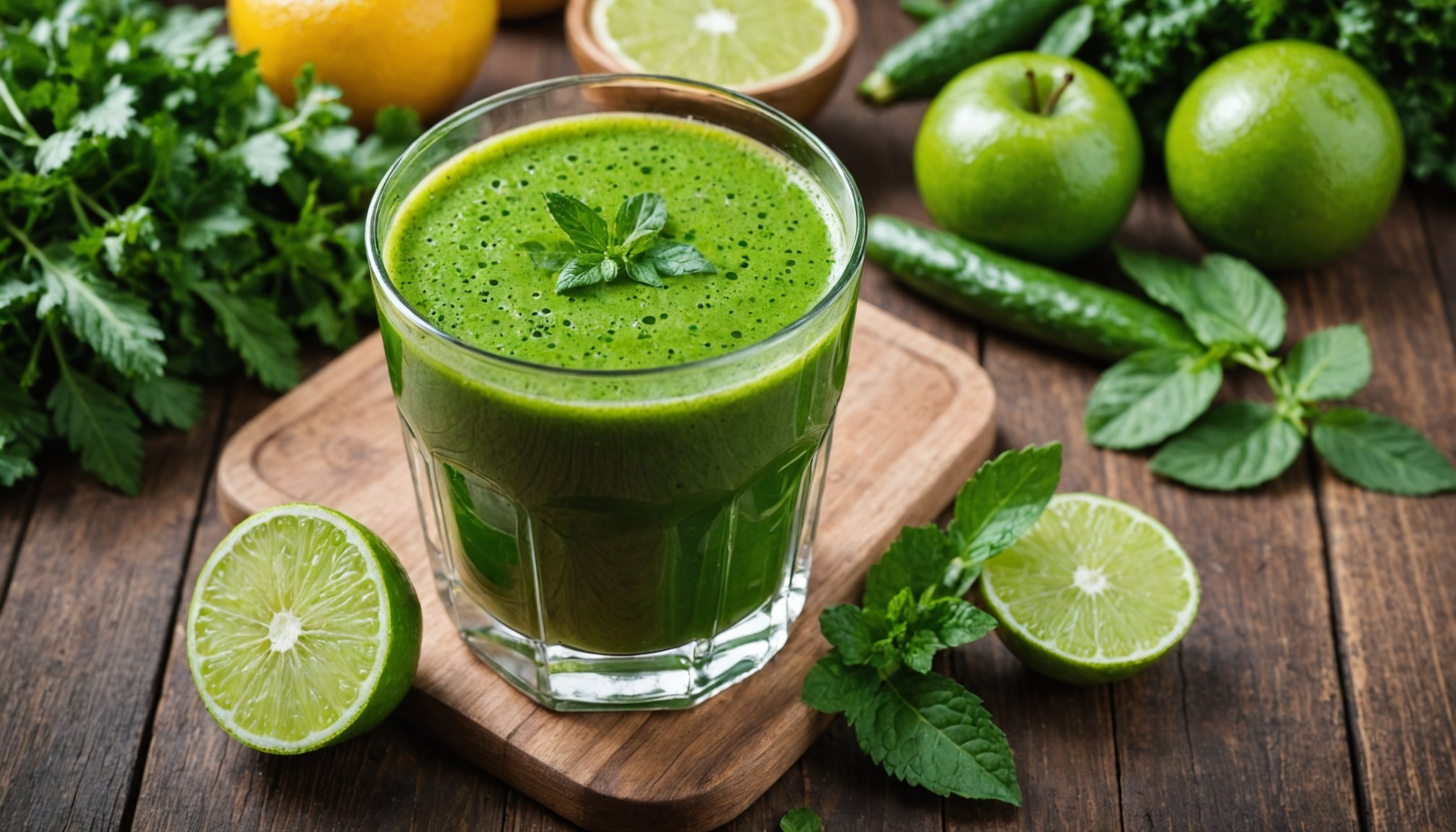Nutritional Benefits of Green Juices
Green juices are well-celebrated for their nutritional advantages, offering a potent dose of essential vitamins and minerals. Common ingredients like kale, spinach, and cucumbers are powerhouses of nutrients such as Vitamin K, Vitamin C, iron, and calcium. These are integral in promoting various bodily functions.
Vitamin K is vital for bone health and effective blood clotting. Meanwhile, Vitamin C contributes significantly to immune function and skin health. Iron is crucial for energy production and transporting oxygen in the blood, while calcium is essential for strong bones and teeth.
Also to discover : Best Core Workouts for Pregnant Women to Prevent Lower Back Pain and Stay Strong
When comparing green juices to whole vegetables, it’s key to understand the principle of nutrient absorption. Juicing can make it easier for our bodies to absorb these nutrients quickly, as the juicing process breaks down the solid matter, freeing up the vitamins and minerals. However, juicing often reduces fiber content, an essential component for digestive health.
In essence, green juices complement whole vegetables, offering an efficient means to consume important nutrients rapidly. Regular inclusion in your diet can nurture health through an array of vitamins and minerals that these vibrant vegetables, when juiced, can deliver.
Also to read : Power-Packed Workouts: Boost Your Heart Health and Sculpt Muscles Simultaneously
Recipes for Delicious Green Juices
Embarking on a journey of vibrant health is as refreshing as the green juices themselves. To get you started, here’s a collection of delightful recipes that cater to both novices and seasoned juicers. Each recipe is crafted to not only tantalise your taste buds but also enhance your well-being.
Simple Green Juice Recipes
For beginners, simplicity is key. Try blending cucumber, celery, and apple for a refreshing mix that’s packed with hydration and vitamin C. This combination is not only delicious but also easy to prepare, requiring just a few ingredients you likely already have in your kitchen. Another beginner-friendly recipe includes spinach, lemon, and ginger, offering a gentle zing while delivering essential nutrients like iron and vitamin C.
Advanced Green Juice Creations
For those comfortable with more complex recipes, exploring advanced creations can be thrilling. Incorporate superfoods like spirulina or wheatgrass along with kale and pineapple for a nutrient-dense drink. This concoction offers a powerful blend of chlorophyll and antioxidants, providing ample detoxification benefits.
Seasonal Green Juice Recipes
Utilising seasonal produce in your juices not only ensures freshness but also maximises flavour and nutrient content. Spring’s bounty offers exciting options such as blending strawberries with arugula and mint, creating a refreshing and nourishing drink perfect for rejuvenating after winter.
Health Tips for Incorporating Green Juices
Embracing green juices as part of your daily routine can be both rewarding and simple. To achieve the best outcomes, select fresh, high-quality ingredients. Prioritise organic produce to minimise exposure to pesticides, which ensures the purity and taste of your juice.
When it comes to frequency, incorporate green juices into a balanced diet. While they are valuable, consuming them once daily is typically advisable unless guided otherwise by a nutrition expert. This frequency helps you enjoy the nutritional benefits without excessive sugar intake.
Portion control is essential too. A serving size of 150-250ml is often optimal—sufficient to provide nutrients without overconsumption.
To enhance your juicing process at home, a few tips can be especially helpful. First, alternate soft and hard ingredients in your juicer to ensure a smooth blend. Experienced juicers recommend starting with leafy greens like kale or spinach, followed by a mix of fruits and hardy veggies.
Keeping your juicer clean is vital. Rinse all parts promptly after use to avoid residues that can impact flavour in subsequent juices.
With these strategies, you’ll find green juicing a delicious and health-positive practice that seamlessly integrates into your life.
Impact of Green Juices on Energy Levels
Green juices can significantly boost energy levels, offering a revitalising influence on daily vitality. Many individuals report feeling more alert and less fatigued after incorporating these nutrient-rich drinks into their routines. But how does it work?
Nutrient absorption plays a vital role here. Green juices, rich in vitamins and minerals like B-vitamins and magnesium, contribute to energy production in the body. For instance, B-vitamins aid in converting food into energy, while magnesium supports various cellular functions that sustain vitality. The juiced form facilitates quicker absorption, enhancing the body’s ability to reap these benefits efficiently.
Drawing from real-life testimonials, many users describe noticeable improvements in their daily energy. They experience less afternoon slumps and enhanced concentration, attributing these positive changes to regular green juice consumption.
Moreover, recent scientific studies highlight the link between nutrient intake and increased energy. These studies indicate that consuming nutrient-dense liquids can sustain energy levels more consistently compared to solid food, due to the swifter absorption and digestibility offered by juicing. In essence, green juices not only awaken the mind but also fuel the body, helping maintain an energetic lifestyle.
Green Juices and Digestive Health
Green juices not only pack a punch with their nutritional content, but they also offer notable digestive benefits. While these vibrant drinks are often low in fiber compared to whole fruits and vegetables, their nutrient-rich profile plays a significant role in gut health.
Key ingredients like spinach and kale are known for their vitamins and minerals that support digestive function. Spinach is rich in magnesium, promoting regular bowel movements, while kale provides nutrients that aid digestion and replenish beneficial gut bacteria.
Juicing makes vitamins and minerals more accessible to the body, potentially improving nutrient absorption. However, fibre, crucial for healthy digestion, is significantly reduced when juicing. To compensate, you can integrate whole foods or fibre-rich smoothies into your diet.
For those sensitive to high-fibre diets, green juices offer a less challenging option to obtain essential nutrients without overwhelming the digestive system.
Certain ingredients enhance these digestive benefits. Ginger, popular in juice blends, aids in alleviating digestive discomfort, while celery is known for its hydrating and detoxifying properties. By incorporating such ingredients, green juices can gently support intestinal health, making them a beneficial part of any balanced diet.
Detoxification Effects of Green Juices
Green juices serve as powerful allies in the body’s natural detoxification processes due to their rich combination of natural detoxifiers. Key ingredients like celery, lemon, and parsley are renowned for their cleansing properties. Celery acts as a diuretic, helping eliminate toxins through increased urine output. Lemon provides Vitamin C, an antioxidant that supports liver detoxification, while parsley contains chlorophyll and flavonoids, known for detox benefits.
Incorporating green juices can enhance the elimination of waste products. This is achieved by providing nutrients necessary for detox pathways while offering hydration, crucial for flushing out toxins. Using fresh, organic produce ensures the best outcomes, as it reduces the risk of toxin reintroduction.
Safe detox practices include integrating juices into a balanced diet. It’s essential not to rely solely on juices for detoxifying but to use them as part of a whole-food, nutrient-rich plan. Start with one glass of green juice daily, and focus on maintaining a diverse and inclusive diet.
By choosing the right ingredients and understanding their roles, you can effectively cleanse and nourish your body. Regular juicing encourages a natural detoxification process that supports overall well-being and enhances vitality.
Engaging Visuals and Infographics
Infographics offer a captivating way to visually understand the nutritional benefits of green juices. By portraying the vitamin and mineral content, these graphics can simplify complex nutritional concepts, helping to clarify how such juices support health. For example, an infographic might illustrate how kale and spinach provide Iron, Vitamin K, and other essential nutrients crucial for body functions like bone health and energy production.
Infographic on Nutritional Benefits
A detailed visual guide can demonstrate the vitamin and mineral content in popular green juice ingredients. You’ll see how each component contributes to your daily nutrient intake. This visual reference aids in comparing nutrient density between ingredients like celery and cucumbers.
Juicing Process Flowchart
Creating your own green juice has never been easier. A step-by-step flowchart can guide you through the home juicing process. From selecting quality produce to understanding portion sizes, these visuals enhance the learning experience, making juicing both accessible and enjoyable.
Before-and-After Testimonials
Visual testimonials can showcase transformative health improvements. Users who have embraced daily juicing often report augmented energy levels. These before-and-after visuals bring their stories to life, encouraging others to start juicing.
Nutritional Benefits of Green Juices
Green juices are celebrated for their nutritional advantages, providing a rich tapestry of essential vitamins and minerals. Key components like kale, spinach, and cucumbers are abundant in nutrients pivotal for optimal health. Vitamin K, found in these ingredients, is crucial for maintaining bone density and proper blood coagulation. Meanwhile, Vitamin C contributes powerfully to immune support and skin vitality.
Iron plays a dual role: it fuels energy by aiding red blood cell creation and facilitates oxygen transportation. Such nutrients, embedded in green juices, promote a holistic well-being approach. Green juices excel in nutrient absorption due to their liquid form, enabling the body to access and absorb these vital compounds rapidly. This efficiency contrasts with whole vegetables, where digestion must first break down the plant structure to release nutrients.
Lastly, the process of juicing enhances the delivery of these nutrients substantially. While whole vegetables still play a critical role in a balanced diet, especially for fibre, green juices offer a swift, nutrient-rich alternative. Integrating green juices into daily routines is a powerful way to ensure a regular intake of these vital nutrients, enhancing overall health and vitality.







